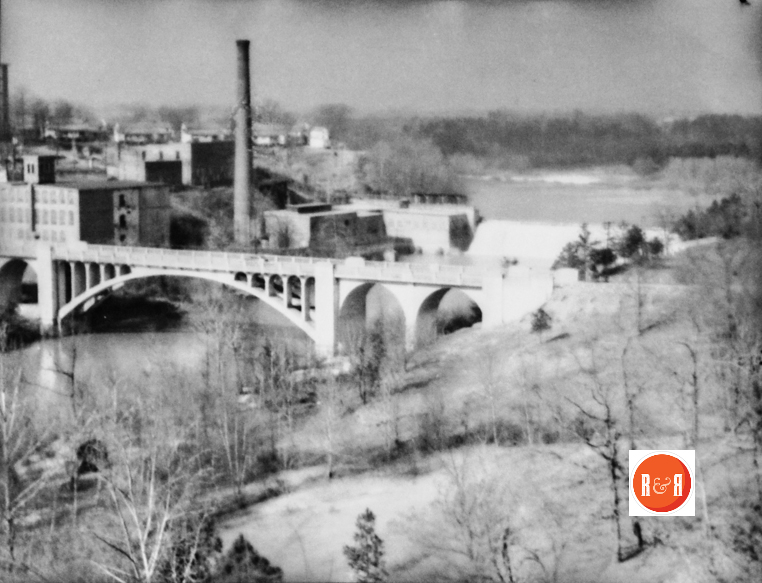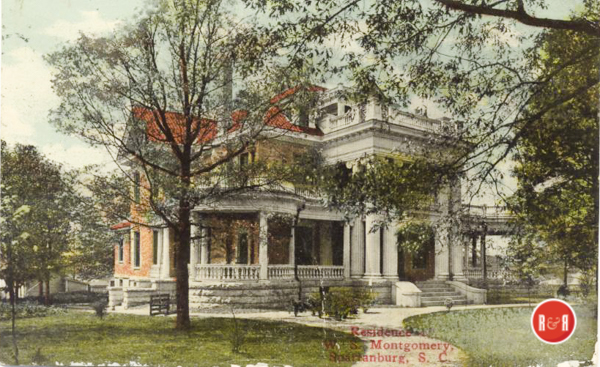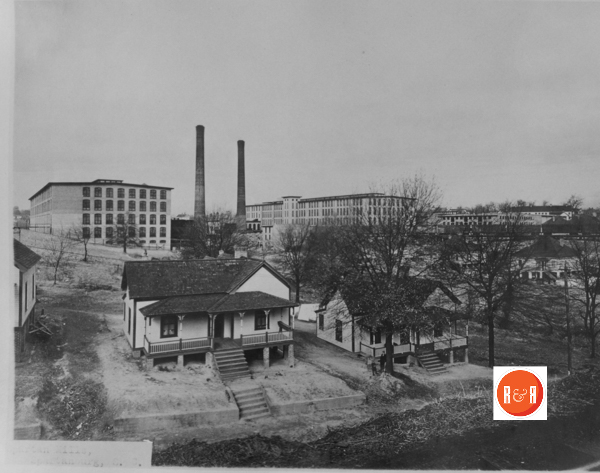
Images courtesy of the Moss – Cobb Collection – 2015. Reportedly the mill following the flood of 1903, and the mill village view below.
The Rock Hill Herald reported on Jan. 22, 1880 – “Mr. Converse has raised over $90,000. for the proposed mill at Hurricane Shoals in Spartanburg County.”
The Rock Hill Herald reported April 1, 1880 – “The Cliffton Factory of Spartanburg has now secured stock in the amount of $200,000. They will put up the necessary buildings and purchase machinery for the first factory.”
The RH Herald reported on March 31, 1881 – “About a year ago, Mr. Converse purchased the old rolling mill site at Hurricane Shoals on the Pacolet River about seven miles from Spartanburg. The previous owner was Mr. Bobo, stock for a new mill was sold for $200,000., which was later increased to $500,000. The place will now be known as Clifton. The mill is three stories and measures 175 ft – 72 feet. They are using a Hercules Turbine Water Wheel made at Holyoke, Mass.”
The Yorkville Enquirer reported on July 10, 1884 – “The Clifton Cotton Factory was forced to stop operations for two days on account of high water in the Pacolet River. Repairs have been made to the wheel and shaft and the mill is back in operation.”
The Yorkville Enquirer of Sept. 14, 1887 reported – “Last week there was a strike by between 75-100 hands at the Clifton Factory. A member of the Knights of Labor was fired resulting in the rest of the group going on strike. They were immediately replaced with new employees and will no longer be employed.”
City Directories and History: The Rock Hill Herald reported on Feb. 7, 1900 – “Reports from Spartanburg Co., are that there are between 50-100 cases of smallpox at Dexter (Clifton Mills #2).”
The Rock Hill Herald reported on Nov. 24, 1900 on mills in Spartanburg Co., S.C. “The Spartan and Whitney mills have declared dividends a number of northern capitalists attended the annual meeting, including Mr. Seth M. Milliken of NY, Mr. Stephen Greene of Boston, and Mr. Sampson of Boston. The annual meeting of the Lockhart Mill was also held Tuesday. There will be a $200,000. cotton mill built at Inman, located on the Charleston and Western Carolina Railroad. Mr. James A. Chapman, a Spartanburg lawyer, will be Pres. and Treasurer.”
The Rock Hill Herald reported on Jan. 25, 1902 – “Mr. W.R. Boney who has been with the Clifton Manufacturing Company for sometime as assistant bookkeeper, has secured a position with the Fairmount Mills near Spartanburg.”
The Rock Hill Herald on Jan. 21, 1903 reported – “Mr. W.R. Boney has returned to Spartanburg from Fairmount where he was employed by the Tyger Manf. Company. He will be with J.P. Stevens in the real estate business.”
The Rock Hill Herald reported on Feb. 25, 1903 – “In an article taken from the Spartanburg Journal, that R.W. Boney, who has been in the insurance business in Spartanburg for sometime, has secured the position as bookkeeper for the Springstein Mills of Chester. In the past he worked with the Tyger River Manuf. Co., of Fairmount.”
The Rock Hill Herald reported on June 10, 1903 on the flooding disaster on the Pacolet River. It reported, over sixty people killed, the Pacolet Mill destroyed, and many houses gone. The three Clifton Mill were wrecked, 3,000 men, women and children gathered around the wreckage. Mill #1 is the least damaged having three stories. There is only a skeleton of mill #2. Many people were swept down the river on drift wood. Dexter Village at mill #2 lost all of its houses and the Converse mill was destroyed.”
RECALLING WHITNEY MILL
I am 63 years old. I am at the point where I now realize our mortality. I appreciate like never before my heritage. My family story on my mother’s side is typical of many of the mill workers’ lives. Spartanburg Mills went up to TN and brought back my maternal great-grandmother and her five daughters. They must have looked a bit like the “Beverly Hillbillies.” They took everything they had and headed to SC on the back of a truck. My great-grandfather was a Cherokee (Blackfoot) who changed his name to “Mr. Black.” He died while blasting through the mountains to forge a way for the railroad. He was buried on the side of the railroad.
My grandmother and two of her sisters resided in Whitney on N Church Street. Her other sisters lived in the same county. My grandmother was Sallie Mae Black, and she married Charles Thomason. All the members of my family on that street worked in the mill there in Whitney. My mother, Ruth Thomason, never worked in the mill. My grandparents were disadvantaged; my grandmother became an invalid and could not work in the mill. Therefore, they were poorer than the others in her family.
They were poor. I still have letters from my grandmother to her sons who served in World War II. She was so happy to get a bit of cheap material to make them clothes. She was so happy when they were able to actually buy their house. It was initially a 4 room house with a porch. Later on an extra long room was built on the back. They did have plumbing. My grandparents had their 5 children in that house. They had 4 boys, all of whom served in World War II. My mom was the baby in the family. When my parents married, they lived in the house with me for 10 years. We rode the city bus. Then a cousin of mom’s came to live in the house, too, on a cot. All she had was a corner for her clothes and belongings.
Thank God for the GI Bill. Two of my uncles graduated from college. Both went into the military career. The oldest lived his adult life in North Charleston and worked in covert operations for the government. The other moved all over the US in the army. One became a sailor up around Baltimore. Uncle Lance owned his own plumbing service and remained there on N Church St.
My dad met my mom in Spartanburg. She worked at the YMCA where my dad lived. Dad was from a farm in Elberton, GA, but he went to Spartanburg to work with his uncle who was a butcher. Thanks to the GI Bill, after he got married to mom – he graduated from Wofford College and then from Southeastern Seminary in Wake Forest. He came home to Whitney on weekends where he pastored a church. He carpooled with other seminarians. They did not have a car until they were married 10 years. They lived in that house with my grandparents. I was born in Spartanburg and lived in Whitney until I was three.
My mom could remember every person who had been kind to her. There was a man who owned a store and sneaked her some candy. She and her brothers felt discrimination. They went to Whitney School, but when they attended Spartanburg High they felt discrimination – they were the “mill hill” kids. She rode a bus and was never able to stay after school for extra-curricular activities. She felt that the teachers favored the city kids. In my opinion, All my uncles and my mom grew up with a bit of a chip on their shoulders – struggling to feel valued and important. All except Lance moved out of the mill village, but the mill village never moved out of them. My uncles refused to eat certain beans because those beans were about the only thing they had to eat. And yes, they were obese from eating fattening food, not being able to buy the healthier food.

Sloan – Epton’s Spartanburg Co Map ca. 1869. Courtesy of the Cobb Collection – Other Side of the River Museum, 2016
I remember the whistle. I remember the party-line phone. I remember the walk to the barber shop with my grandfather. I remember the whole family going to my aunt’s house to see her daughter and husband fight almost every Friday night. That was our entertainment. And the snuff. Oh Lord. The women, too. I can see them now with that snuff coming out the sides of their mouths.
They loved those soft ball games. They loved their music, especially the Sunday morning quartets. My grandfather had a picture of Roosevelt on the wall. He campaigned for Democrats.
My grandmother was the godliest of her family. While the other siblings looked Cherokee, she had very light skin and red hair. I played on her bed. She made me scrap books. She loved for the family to sing. They all sang “We Will Understand It Better By and By.” I always wondered why her songs were so sad. Mom actually got to take piano lessons and became the church pianist. My grandfather was not a Christian. Whitney Baptist Church meant “the world” to my immediate family. I don’t know why my grand mother was the most religious. Maybe because she suffered so much pain. Her children all grew up in the church and remained active church goers their whole lives. I don’t think the others did. Some of their names were “Lizzie,” “Maggie,” and “Edna”.
Around the late 1960s I would visit my cousin Beth Thomason who lived on N Church. I loved working in the peach shed. I also enjoyed the sock hops at Whitney School. After the late 1960s I didn’t go to Whitney often. I attended some of their revivals. They loved those revivals. One Sunday the Methodist would use the church. Then, the Baptist used the church. By the time I was in elementary, each denomination had its own church.
My dad’s side were farmers. They were all able to go to school year-round and much more sophisticated people. My dad’s mother’s family went to college. One became a doctor and another , a teacher. They were so well mannered and used polite table etiquette. But not my mom’s family. My mom liked some of the life; she was grateful she had what she had, but she wanted out of the mill village. She suffered emotionally because of the stigma of the mill hill people – unhealthy, unclean, diseases, coarse, –had so much less than others. I tried to explain to her why those were stigmas, not condoning them but trying to understand them. She never went back to high school reunions. It was painful. She should have. She married Norris Hill, one good looking man right out of the military – one with black hair and brown eyes – some of her peers back home said he looked like Elvis. I though he looked more like Perry Mason. Children remember what adults and others say about them. Mom never had good self-esteem.
And I wonder about the blacks. As poor as we were, we had some help once a week. A woman named Agnes was like another mother. A story about her later.
Over the past ten years I have wanted to give homage to these dear mill workers. Their hard work, tough constitutions and pride are now inspirations. Out of my grandparents’ five children came 9 grands. Seven graduated from college, and the others went straight into good jobs. Four of them earned a master’s degree. I am a minister – actually a Reverend. My husband and I served Connie Maxwell Children’s Home for 20 years. My brother is a lawyer.
My husband is a Reverend. He is now retired but is the President of the Greenwood Rotary and teaches two classes at Lander University. My brother’s wife has more degrees than a thermometer. She came from a family that was involved in the mill villages in the Chester area. Martha has three masters.
Those mill workers modeled for us a great work ethic. Most were Christian people. Most of my mom’s peers valued education although the ones before her did not. They appreciated every thing that was given to them. They didn’t expect anything to be given, but they sure appreciated it when people were kind and generous.
I will tell you quite frankly that I am financially well-off. I married a man who was a minister – no money there, but my husband’s father was a businessman. We met in seminary at Southern in Louisville, Ky. I feel absolutely overwhelmed at what my ancestors gave to me “on a silver platter.” They worked for every bit of food, clothes, education —everything to provide for the family and give them more than they had. I didn’t show them as much respect and family lore as I should have.
Written and submitted to R&R by – Sally Kauffmann of Greenwood, S.C., 10.16.16
———————
WHITNEY MILL HISTORY: “The Whitney Manufacturing Company, capital stock $193,000, is another one of those magnificent industries within a mile of Spartanburg which sprang into existence almost within a fortnight. These mills began operations L.P. Walker, A.H. Foster, J.H. Montgomery, J.A. Henneman, and C.E. Fleming. R.L. Cumnock is superintendent. The mills are on the old Harris Mill site and the water power is excellent. The main building of the mills is 263 feet long and 78 feet wide and three stories high. The two hundred operatives are comfortably housed in about forty tenements. A school and a handsome church are also provided by the company.” (Reprinted from South Carolina in the 1880s: A Gazetteer by J.H. Moore, Sandlapper Publishing Company – 1989)
Stay Connected
Explore history, houses, and stories across S.C. Your membership provides you with updates on regional topics, information on historic research, preservation, and monthly feature articles. But remember R&R wants to hear from you and assist in preserving your own family genealogy and memorabilia.
Visit the Southern Queries – Forum to receive assistance in answering questions, discuss genealogy, and enjoy exploring preservation topics with other members. Also listed are several history and genealogical researchers for hire.
User comments welcome — post at the bottom of this page.
Please enjoy this structure
 and all those listed in Roots and Recall. But remember each is private property. So view them from a distance or from a public area such as the sidewalk or public road.
and all those listed in Roots and Recall. But remember each is private property. So view them from a distance or from a public area such as the sidewalk or public road.
Do you have information to share and preserve? Family, school, church, or other older photos and stories are welcome. Send them digitally through the “Share Your Story” link, so they too might be posted on Roots and Recall.
Thanks!














